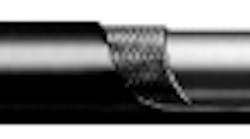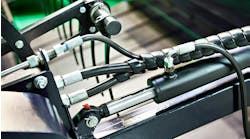Download this article in .PDF format
To say that hose is an important part of a hydraulic system is a huge understatement. The flexibility of hose enables components to be positioned in the most efficient or convenient places, because the hose has the ability to bend around corners, through tight spaces, or across long distances.
Yet these days, there seems to be as many different types of hose as there are telephone long-distance carriers. How does a designer tell one from the other? Isn't there an easy way to choose or compare hoses?
The SAE standards
SAE answers those questions with its J517 hydraulic hose standard. This hose standard serves as the most popular benchmark in the realm of industrial hydraulics today. More specifically, J517 is a set of guidelines that applies to the current SAE 100R series of hoses. Currently, 16 such hose styles exist, and they are designated as 100R1 through 100R16 (see descriptions, pages A105 and 106). Each of the styles must meet a set of dimensional and performance characteristics as set forth by SAE. However, SAE issues no approval source lists, certification, or letters of approval-conformance to these standards by manufacturers is strictly voluntary. In short, the standards only assure a similarity of products among different manufacturers.
Hydraulic hose construction
Modern hydraulic hose typically consists of at least three parts: an inner tube that carries the fluid, a reinforcement layer, and a protective outer layer.
The inner tube must have some flexibility and needs to be compatible with the type of fluid it will carry. Commonly used compounds include synthetic rubber, thermoplastics, and PTFE, sometimes called Teflon. The reinforcement layer consists of one or more sheaths of braided wire, spiral-wound wire, or textile yarn. The outer layer is often weather-, oil-, or abrasion-resistant, depending upon the type of environment the hose is designed for.
Not surprisingly, hydraulic hoses have a finite life. Proper sizing and use of the correct type of hose will certainly extend the life of a hose assembly, but there are many different factors that affect a hose's lifespan. SAE identifies some of the worst offenses as:
- flexing the hose to less than the specified minimum bend radius
- twisting, pulling, kinking, crushing, or abrading the hose
- operating the hydraulic system above maximum or below minimum temperature
- exposing the hose to rapid or transient rises (surges) in pressure above the maximum operating pressure, and
- intermixing hose, fittings, or assembly equipment not recommended as compatible by the manufacturer or not following the manufacturer's instructions for fabricating hose assemblies.
Selecting the proper hose
Here are seven recommended steps the system designer should follow during the hose and coupling selection process. To help determine the proper hose for an application, use the acronym STAMPED - from Size, Temperature, Application, Materials, Pressure, Ends, and Delivery. Here is what to consider in each area:
Size - In order to select the proper hose size for replacement, it is important to measure the inside and outside hose diameters exactly using a precision-engineered caliper, as well as the length of the hose. Hose OD is particularly important when hose-support clamps are used or when hoses are routed through bulkheads. Check individual hose specification tables for ODs in suppliers' catalogs. When replacing a hose assembly, always cut the new hose the same length as the one being removed. Moving components of the equipment may pinch or even sever too long a hose. If the replacement hose is too short, pressure may cause the hose to contract and be stretched, leading to reduced service life.
Changes in hose length when pressurized range between +2% to 4% while hydraulic mechanisms are in operation. Allow for possible shortening of the hose during operation by making the hose lengths slightly longer than the actual distance between the two connections.
Temperature - All hoses are rated with a maximum working temperature ranging from 200° to 300° F based on the fluid temperature. Exposure to continuous high temperatures can lead to hoses losing their flexibility. Failure to use hydraulic oil with the proper viscosity to hold up under high temperatures can accelerate this problem. Always follow the hose manufacturer's recommendations.
Exceeding these temperature recommendations can reduce hose life by as much as 80%. Depending on materials used, acceptable temperatures may range from -65° F (Hytrel and winterized rubber compounds) to 400° F (PTFE). External temperatures become a factor when hoses are exposed to a turbo manifold or some other heat source.
When hoses are exposed to high external and internal temperatures concurrently, there will be a considerable reduction in hose service life. Insulating sleeves can help protect hose from hot equipment parts and other high temperature sources that are potentially hazardous. In these situations, an additional barrier is usually required to shield hydraulic fluid from a potential source of ignition.
Application - Will the selected hose meet bend radius requirements? This refers to the minimum bend radius (usually in inches) that a hydraulic hose must meet. Exceeding this bend radius (using a radius smaller than recommended) is likely to injure the hose reinforcement and reduce hose life.
Route high-pressure hydraulic lines parallel to machine contours whenever possible. This practice can help save money by reducing line lengths and minimizing the number of hard-angle, flow-restricting bends. Such routing also can protect lines from external damage and promote easier servicing.
Materials - It is mandatory to consult a compatibility chart to check that the tube compound is compatible with the fluid used in the system. Elevated temperature, fluid contamination, and concentration will affect the chemical compatibility of the tube and fluid. Most hydraulic hoses are compatible with petroleum-based oils. Note that new readily biodegradeable or green fluids may present a problem for some hoses.
Pressure capabilities - Hose working pressure must always be chosen so that it is greater than or equal to the maximum system pressure, including pressure spikes. Pressure spikes greater than the published working pressure will significantly shorten hose life.
Hose ends - The coupling-to-hose mechanical interface must be compatible with the hose selected. The proper mating thread end must be chosen so that connection of the mating components will result in leak-free sealing.
There are two general categories of couplings to connect most types of hose: the permanent type (used primarily by equipment manufacturers, large-scale rebuilders, and maintenance shops) and the field-attachable type.
Permanently attached couplings are cold-formed onto the hose with powered machinery. They are available for most rubber and thermoplastic hoses and offer a wide range of dependable connections at low cost. Assemblies made in the field with portable machines are relatively simple; these machines are economical and easy to operate. In most cases, it is not necessary to skive the cover. These couplings are less complicated to install than other types.
Field-attachable couplings are classified as screw-together and clamp-type. The screw-together coupling attaches to the hose by turning the outer coupling shell over the outside diameter of the hose. The coupling insert is then screwed into the coupling shell. A clamp-type coupling has a 2-piece outer shell that clamps onto the hose OD with either two or four bolts and nuts.
In either case, the coupling has limited potential for reuse because the threads distort during attachment.
To ensure the correct-size coupling is used when replacing an assembly, the number of threads per inch and thread diameter of the original coupling must be determined. Thread pitch gages are available for identifying the number of threads per inch. A caliper can measure both inside and outside dimensions of the threads. ODs are measured on male couplings, while IDs are measured on female couplings.
In most situations, the only differences between an SAE coupling and an imported coupling are the thread configuration and the seat angle. International thread ends can be metric, measured in mm, but also include BSP (British Standard Pipe) threads, which are measured in inches. Knowing the country of origin provides a clue as to what type of thread end is used. DIN (Deutsche Industrial Norme) fittings began in Germany and now are found throughout Europe, while BSP is found on British equipment. Japanese Komatsu machinery uses Komatsu fittings with metric threads, while other Japanese equipment most likely uses JIS (Japanese Industrial StandardBSP threads), or, in some cases, BSP with straight or tapered threads.
Three determinations are required to identify these couplings correctly:
- type of seat - inverted (BSPP & DIN), regular (JIS & Komatsu) or flat (flange, flat-face)
- seat angle - 30° (JIS, BSP, DIN and Komatsu) or 12° (DIN), and
- type of threads - metric (DIN or Komatsu), BSP (BSPP, BSPT or JIS), or tapered (BSPT or JIS Tapered)
SAE standards relating to hydraulic/pneumatic fittings and assemblies specifically designed to eliminate leakage include:
- J514 - straight thread ports/fittings
- J518c - 4-bolt flange ports/fittings, and
- XJ1453 - the number provisionally assigned to O-ring face seal fittings.
Delivery - How available is the product? Is it unique? How soon can it be delivered to the distributor or end user? It may be preferable to consider several options to maximize flexibility and avoid the delays that can result from relying on components that are unavailable or in short supply.
| Type of fluid | Pressure range | |||||||
| SAE# | Petroleum oil | Synthetic oil | High-water content | Temp.* | psi | ID, in. | psi | ID, in. |
|---|---|---|---|---|---|---|---|---|
| 100R1 | x | x | 1 | 3,000 | 3/16 | 375 | 2 | |
| 100R2 | x | x | 1 | 5,000 | 3/16 | 1,000 | 2-1/2 | |
| 100R3 | x | x | 1 | 1,500 | 3/16 | 375 | 1-1/4 | |
| 100R4 | x | x | 1 | 300 | 3/4 | 35 | 4 | |
| 100R5 | x | x | 1 | 3,000 | 3/16 | 200 | 3 | |
| 100R6 | x | x | 1 | 500 | 3/16 | 300 | 3/4 | |
| 100R7 | x | x | x | 2 | 3,000 | 3/16 | 1,000 | 1 |
| 100R8 | x | x | x | 2 | 5,000 | 3/16 | 2,000 | 1 |
| 100R9 | x | x | 1 | 4,500 | 3/8 | 2,000 | 2 | |
| 100R10 | x | x | 1 | 10,000 | 3/16 | 2,500 | 2 | |
| 100R11 | x | x | 1 | 12,500 | 3/16 | 2,500 | 2-1/2 | |
| 100R12 | x | x | 3 | 4,000 | 3/8 | 2,500 | 2 | |
| 100R13 | x | x | 3 | 5,000 | 3/4 | 5,000 | 2 | |
| 100R14 | x | x | x | 4 | 1,500 | 1/8 | 600 | 1-1/8 |
| 100R15 | x | 3 | 6,000 | 3/8 | 6,000 | 1-1/2 | ||
| 100R16 | x | x | 1 | 5,000 | 1/4 | 1,625 | 1-1/4 | |
| * Temperatures: 1 = -40° to 100°C; 2 = -40° to 93°C; 3 = -40° to 121°C; 4 = -54° to 204°C | ||||||||
This hose should be used in low pressure and vacuum applications, with petroleum- and water-based hydraulic fluids, within a temperature range from -40° to 100° C. It is constructed with an inner tube of oil-resistant synthetic rubber, a reinforcement consisting of a ply, or plies, of woven or braided textile fibers with a suitable spiral of body wire, and an oil- and weather-resistant synthetic rubber cover.SAE 100R5

















